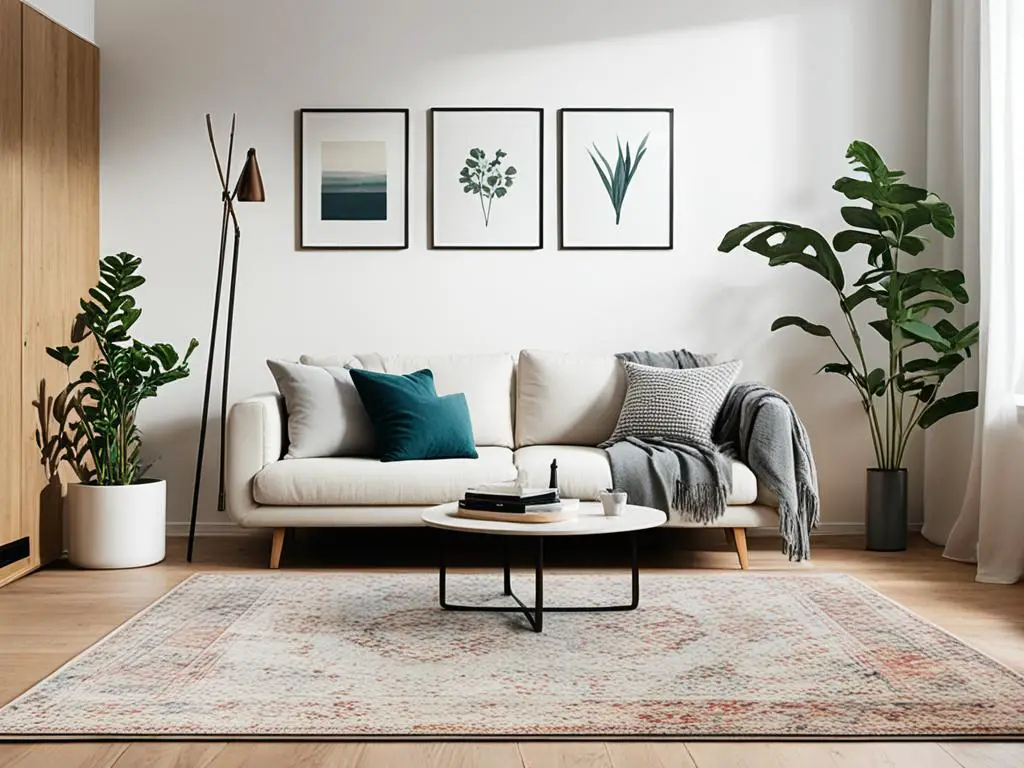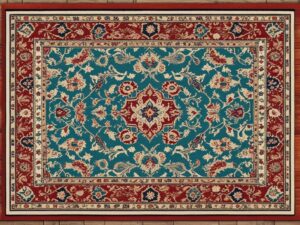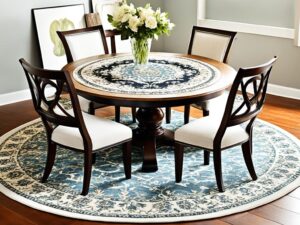When it comes to decorating your home, utilizing the same rug twice can be a practical and stylish choice. Not only does it save you money, but it also creates a cohesive look and ties different rooms together. Rugs play a vital role in establishing the foundation of your decor, defining and coordinating spaces, especially in open floor plans.
Before deciding to reuse a rug, consider the material and its durability. A rug made from high-quality fibers is more likely to withstand the wear and tear of being used in multiple rooms. Additionally, coordinating colors is essential to ensure that the rug complements the existing color scheme in both spaces.
Choosing the right size rug for each room is crucial. Too small, and it will make the area appear cramped, while too large can overpower the space. Pay attention to rug shapes as well, as playing with different shapes can add visual interest to your home.
Don’t forget about maintaining symmetry when using the same rug in multiple areas. This creates a sense of balance and thoughtfulness in your interior design. If you’re looking to add versatility and visual intrigue, consider layering rugs for a unique and personalized touch.
In conclusion, reusing rugs in your decor offers practicality and creativity. By considering factors like material, color coordination, size, placement, and the opportunity to personalize, you can confidently use the same rug multiple times and create a stylish and inviting space that reflects your personal style.
Key Takeaways:
- Reusing the same rug in your home can create a cohesive and stylish look.
- Rugs act as a foundation for decor, defining and coordinating spaces in open floor plans.
- When reusing rugs, consider the material, coordinate colors, choose the right size, and play with different rug shapes.
- Maintaining symmetry adds balance to your interior design, while layering rugs can add versatility and visual intrigue.
- Your choice of rugs should reflect your personal style and make you feel happy in your home.
Matching Rugs for Living and Dining Rooms
Matching rugs in the living room and dining room can be a brilliant design choice. It not only adds elegance and sophistication but also creates a sense of unity and harmony between these two important areas of your home. By using matching rugs, you lay the foundation for the rest of the decor in both rooms, establishing a cohesive look that ties everything together.
When it comes to designing with matching rugs, you have the opportunity to explore mixing and matching other decorative elements such as artwork and furniture. Choosing complementary pieces will enhance the overall aesthetic of your living and dining areas, creating a space that feels balanced and well-curated.
Matching rugs in the living and dining rooms can serve as a visual clue, guiding your design choices and assisting in the coordination of various decorative elements.
One of the reasons why matching rugs work so well is their ability to define and coordinate spaces, especially in open floor plans. With no physical boundaries between the living and dining areas, rugs act as delineators, helping to visually separate the spaces and guide furniture arrangement. They give each room a distinct identity and purpose while maintaining a sense of unity.
By incorporating matching rugs, you invite visitors to notice similarities between the living and dining areas. This subtle repetition in design elements fosters continuity throughout your home, allowing for a seamless flow as you move from one room to another. It also provides a platform for further design decisions, ensuring that your choices remain cohesive and complementary.
Benefits of Matching Rugs for Living and Dining Rooms
| Benefits | Description |
|---|---|
| Creates a Cohesive Look | Matching rugs establish a consistent and harmonious visual theme throughout your living and dining areas. |
| Coordinates Decorative Elements | Matching rugs provide a foundation for coordinating other decorative elements like artwork and furniture, resulting in a unified and well-curated space. |
| Defines and Coordinates Spaces | Rugs act as delineators in open floor plans, defining and visually separating the living and dining areas while maintaining a sense of unity. |
| Invites Design Continuity | Repeated design elements in the form of matching rugs create a seamless flow between rooms, informing further design choices and maintaining a cohesive aesthetic. |
(img src=”https://seowriting.ai/32_6.png” alt=”matching rugs in living and dining rooms”)
Matching rugs in the living room and dining room can transform your space, creating a cohesive and well-designed environment. They serve as the foundation for your decor and set the stage for a stylish and inviting atmosphere. By carefully selecting and placing matching rugs, you can define spaces, coordinate elements, and inspire a sense of unity in your open floor plan. Embrace the versatility and beauty of matching rugs and watch as they transform your living and dining areas into stunning spaces.
Practical Tips for Using Matching Rugs
When it comes to using matching rugs in both your dining room and living room, there are some practical tips to consider. These tips will help you create a cohesive and stylish look that ties both spaces together. From material considerations to adding personal touches, here are some tips to keep in mind:
Material Considerations
It’s important to choose the right material for each room. In the dining room, opt for rugs made from easy-to-clean materials like seagrass or polypropylene. These materials are durable and can withstand spills and stains common in dining areas. In the living room, you can choose softer materials like wool or cotton, which provide a cozy and comfortable feel.
Coordinating Colors
When using matching rugs, coordinating colors is key. Ensure that the color palette of the rugs complements the existing color scheme in both the dining and living rooms. This will create a harmonious and visually pleasing atmosphere.
Choosing the Right Size
Size matters when it comes to rugs. Choosing the right size for each space is crucial to avoid making the room look too small or cramped. Measure the dimensions of each room and select rugs that fit accordingly. A rug that is too small can make the room feel unbalanced, while a rug that is too large can overpower the space.
Playing with Rug Shapes
Don’t be afraid to play with different rug shapes, especially if the room has unique architectural features. A round rug can soften the corners of a square or rectangular dining table, while a rectangular rug can create a sense of length in a living room. Mixing and matching shapes can add visual interest and variety to your overall decor.
Maintaining Symmetry
Creating symmetry in rug placement can bring a sense of balance and thoughtfulness to your interior design. In the dining room, center the rug under the dining table to create a focal point. In the living room, place the rug in a way that complements the arrangement of furniture. This will help define the space and create a cohesive look.
Layering Rugs
Layering rugs is a great way to add versatility and visual intrigue to your space. Consider layering a smaller rug on top of a larger one to create depth and texture. You can mix patterns and textures to create a unique and personalized look that reflects your style and personality.
Adding Personal Touches
Lastly, don’t be afraid to add personal touches to your rugs. This can be through the use of decorative elements like tassels or fringe, or even by customizing the rug with a monogram or pattern that reflects your personal style. These personal touches will make the space feel unique and truly yours.
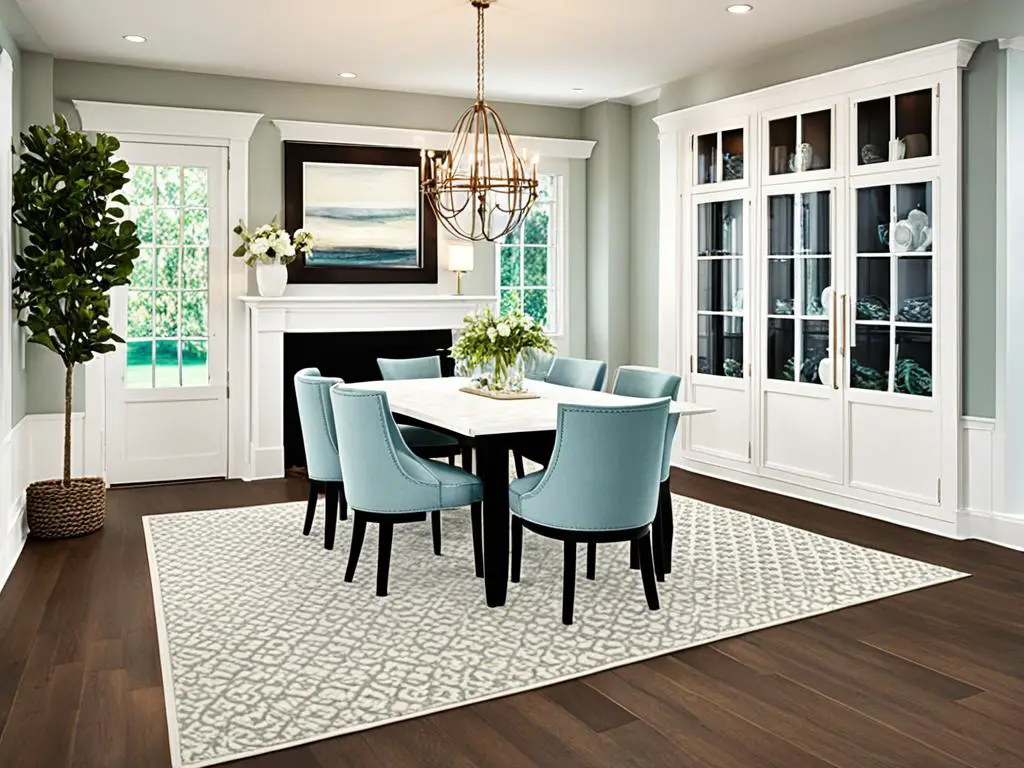
| Tips for Using Matching Rugs | Description |
|---|---|
| Consider the material | Choose rugs made from easy-to-clean materials for the dining room, and softer materials for the living room. |
| Coordinate colors | Ensure that the rug’s color palette complements the existing color scheme in both rooms. |
| Choose the right size | Select rugs that are the appropriate size for each space to maintain a balanced and proportionate look. |
| Play with rug shapes | Experiment with different rug shapes to add visual interest and work with the room’s architecture. |
| Maintain symmetry | Create a sense of balance by placing rugs in a way that maintains symmetry within the room. |
| Layer rugs | Add depth and texture by layering rugs of different sizes and patterns. |
| Add personal touches | Customize your rugs with decorative elements or patterns that reflect your personal style. |
Using the Same Rug in Different Rooms
When it comes to creating a cohesive look throughout your home, using the same rug in different rooms can be a game-changer. It brings a sense of continuity and harmony to your overall decor. However, there are a few considerations to keep in mind to ensure a successful and visually appealing outcome.
Choosing the Right Size
Before you start using the same rug in different rooms, it’s important to consider the size of the rug. Each room may have different dimensions, so make sure the rug fits appropriately in each space. A rug that is too small can make the room feel disjointed, while a rug that is too large can overwhelm the space.
Coordinating Colors and Designs
Another important aspect to consider is coordinating the colors and designs of the rug with the overall decor in each room. The rug should complement the color palette and design elements, enhancing the cohesive look you’re aiming for. If your rooms have different color schemes, choose a rug that incorporates the common colors to tie everything together.
Varying Rug Placement
While using the same rug in different rooms, it’s essential to vary the placement to maintain visual interest and variety. Instead of placing the rug in the exact same way in every room, try experimenting with different orientations and angles. This will add depth and dimension to each space while still maintaining a cohesive aesthetic.
Visual Balance in Irregular Spaces
For rooms with irregular shapes or unique architectural features, aiming for visual balance rather than strict symmetry is key. Adapt the rug placement to accommodate the room’s peculiarities. This will create a harmonious blend between the rug and the room, ensuring a cohesive and visually pleasing look.
One idea to achieve visual balance is to use one rug as an area rug in one room and another as a runner in a hallway or adjacent space. This approach maintains a sense of continuity while allowing each room to have its own individual style.
Using the same rug in different rooms can transform your home into a cohesive and visually enchanting space. By considering the size of the rug, coordinating colors and designs, varying the rug placement, and striving for visual balance in irregular spaces, you can create a seamless flow throughout your home that showcases your personal style and creates a welcoming environment.
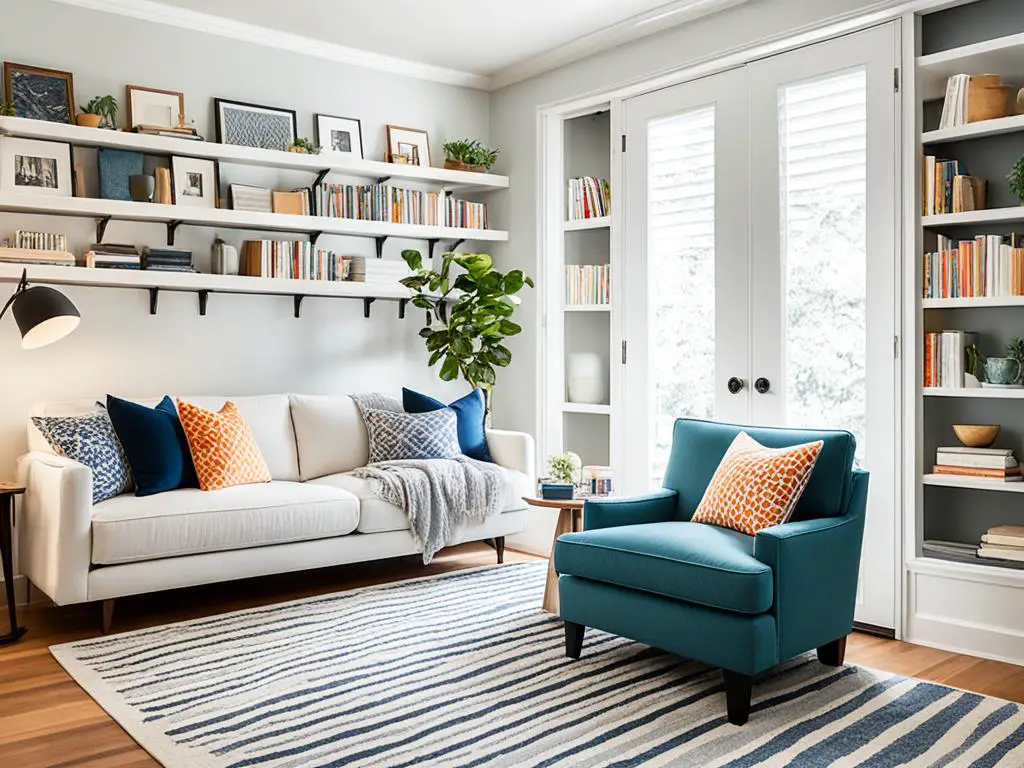
“Using the same rug in different rooms can bring a sense of harmony and continuity to your home decor, creating a visually pleasing and cohesive look.”
Conclusion
Reusing rugs in decor is a practical and creative way to refresh your space. Instead of investing in new rugs, you can easily repurpose the same rug in different rooms or areas of your home. This not only saves you money but also creates a cohesive look that ties your entire space together.
Rugs play a crucial role as a foundation for all other decor elements. By using the same rug multiple times, you establish a consistent style and visual flow throughout your home. This is particularly beneficial in open floor plans where rugs can define and coordinate different areas, creating a harmonious and well-designed space.
When reusing a rug in different rooms, consider factors such as material, color and design coordination, size, placement, and the opportunity to add personal touches. By carefully selecting the right rug and implementing creative styling ideas, you can confidently decorate your space with the same rug multiple times, achieving a fresh and inviting look every time.
So, whether you have a beloved rug that you want to showcase in different areas of your home or want to experiment with different styles using the same rug, don’t hesitate to embrace the practicality and versatility of reusing rugs in your decor. With a little creativity and attention to detail, you can transform your space and enjoy the benefits of a cohesive, stylish, and rejuvenated home.
